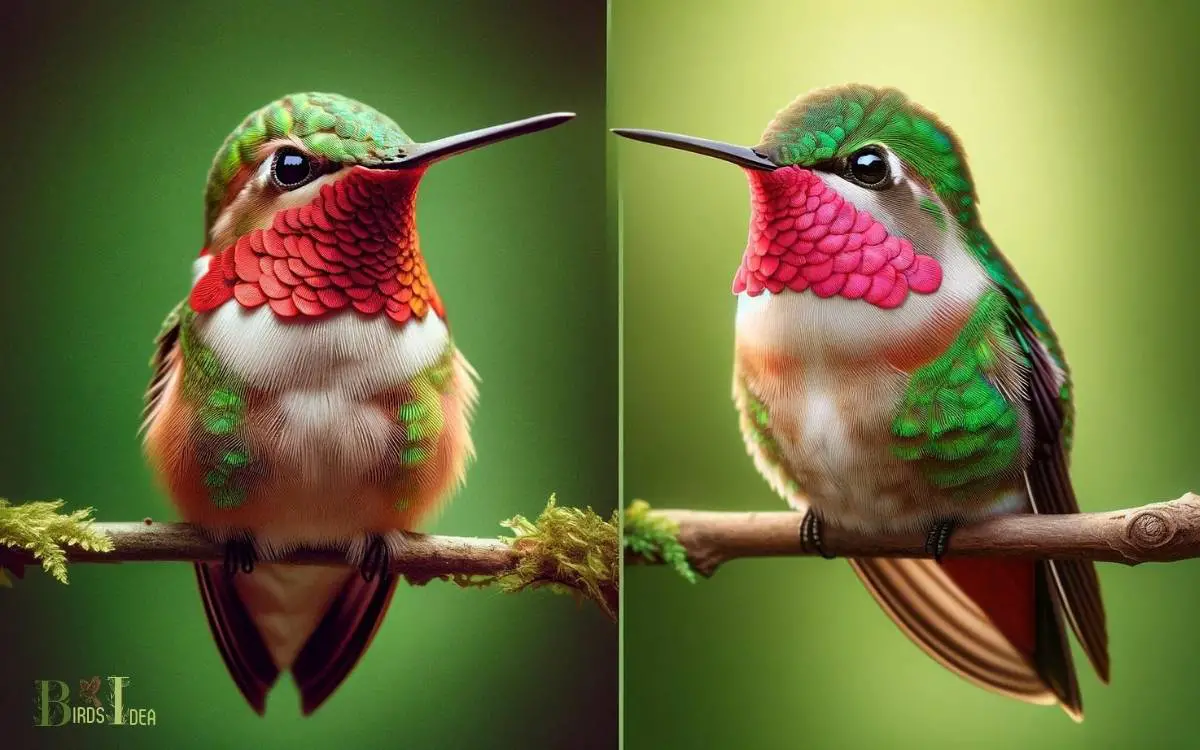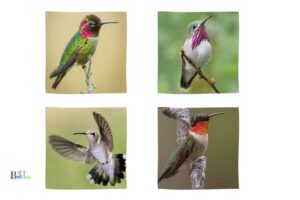Ruby Throated Hummingbird Male Vs Female: Competition!
The Ruby-Throated Hummingbird is a species known for its vibrant coloration and dynamic flight patterns. Male Ruby-Throated Hummingbirds display a brilliant red throat or gorget, which is absent in females.
Males have a forked black tail with a violet sheen, whereas females feature a rounded tail with white tips. Both sexes exhibit a metallic green back and crown with grayish-white underparts.
Ruby-Throated Hummingbirds are sexually dimorphic, meaning males and females have different physical appearances.
Here are some key differences:
For example, when trying to attract a mate, a male Ruby-Throated Hummingbird will perform a series of U-shaped dives to showcase its ruby throat and agility.
Discover the enchanting world of Ruby-Throated Hummingbirds, where the males boast iridescent ruby throats and the females charm with understated elegance.

Key Takeaway
Physical Differences
The physical differences between male and female ruby-throated hummingbirds are primarily manifested in their size and coloration. Male hummingbirds are generally smaller and more compact than their female counterparts.
Their iridescent feathers display vibrant shades of emerald green on their back and head, with a striking ruby-red throat patch, from which the species derives its name.
In contrast, female ruby-throated hummingbirds are slightly larger and lack the iridescent throat patch, displaying more subdued plumage with a white or light gray throat.
These differences in size and coloration are essential for species identification and play a crucial role in courtship and mating behaviors. Understanding these physical disparities is fundamental in the study and conservation of these remarkable birds.
Plumage Variation
Male and female ruby-throated hummingbirds exhibit distinct plumage variations. The male displays iridescent emerald green feathers, which shimmer and change in the light, giving a captivating display to attract mates.
Its most striking feature is the vibrant ruby-red throat patch, known as a gorget, which becomes even more brilliant during courtship displays.
In contrast, the female showcases more subdued plumage with a white or pale throat and lacks the iridescent throat patch. The female’s feathers are primarily a soft greenish-gray, providing her with better camouflage while nesting and gathering food.
These plumage differences serve essential functions in courtship and survival, allowing for easy visual distinction between the sexes and adaptation to their respective roles in reproduction and raising offspring.
Size Discrepancies
Male and female Ruby-throated hummingbirds exhibit noticeable size discrepancies, with the male typically having a larger tail and the female being shorter overall.
These differences in size are also reflected in their weight, with the male being heavier than the female. It is fascinating to observe these distinct physical variations between the two genders of this remarkable species.
Male Larger Tail
A noticeable size difference exists in the tail feathers of the male and female Ruby Throated Hummingbirds.
In the case of the male, the tail feathers are notably longer, extending beyond the wingtips when in flight. This size discrepancy serves a specific purpose in the male’s courtship displays.
During the breeding season, the male utilizes its longer tail feathers to perform elaborate aerial displays, where it ascends to great heights before rapidly diving, creating a distinct whirring sound with its tail feathers.
These displays are designed to attract females and establish territory. The longer tail feathers of the male not only aid in these acrobatic displays but also serve as a visual cue for potential mates, indicating the male’s fitness and genetic quality.
This size difference in tail feathers plays a crucial role in the reproductive behavior and success of the Ruby Throated Hummingbird species.
Female Shorter Overall
The female Ruby Throated Hummingbird exhibits overall smaller dimensions compared to the male, with differences in body size, tail length, and bill length contributing to the size discrepancies between the sexes.
- Body Size: Female hummingbirds are generally 25-30% smaller in body mass compared to males.
- Tail Length: The tail of the female is proportionally shorter in comparison to the male, with an average length of 1.12 inches.
- Bill Length: Female hummingbirds have shorter bills, measuring around 0.79 inches in length on average.
These size differences are not only crucial in distinguishing the male from the female but also play significant roles in their foraging behaviors, flight patterns, and reproductive strategies.
Understanding these disparities provides valuable insights into the ecological and evolutionary dynamics of the species.
Weight Differences Noticeable
With the noticeable differences in body size, tail length, and bill length between the male and female Ruby Throated Hummingbirds established, the weight variations further highlight the distinct size discrepancies between the sexes.
Male Ruby Throated Hummingbirds typically weigh around 3.4 grams, while females tend to be slightly heavier, weighing in at approximately 3.8 grams. This weight difference may seem minimal, but in the world of hummingbirds, it is significant.
The male’s smaller size and lighter weight enable it to be more agile and maneuver swiftly during courtship displays and territorial defense.
Conversely, the female’s slightly larger build supports the energy demands of egg production and nesting activities. These weight variances are crucial adaptations that align with the respective roles and behaviors of each sex within the species.
Behavioral Variances
In an article titled ‘Ruby Throated Hummingbird Male Vs Female’, behavioral variances between the two genders are evident in their foraging habits and territorial behavior.
Foraging Habits:
- Males often exhibit more daring and aggressive foraging behavior, venturing into unfamiliar territories in search of nectar sources.
- Females, on the other hand, tend to be more cautious and selective in their foraging, often preferring familiar and resource-rich areas to minimize the risk of predation.
Territorial Behavior:
- Male ruby-throated hummingbirds are known for their territorial nature, vigorously defending prime feeding locations to attract mates and establish dominance.
- Females, while also defending feeding territories, tend to be less aggressive and prioritize the protection of nesting sites over feeding areas.
These behavioral differences reflect the distinct ecological roles and reproductive strategies adopted by male and female ruby-throated hummingbirds.
Mating Behavior
The mating behavior of Ruby-throated hummingbirds exhibits distinct differences between males and females. Males often perform elaborate aerial displays, including high-speed dives and U-shaped flights, to attract females and establish territory.
In contrast, females engage in courtship feeding behaviors, where they solicit food from males as part of the mating ritual.
Mating Display Differences
Male and female Ruby Throated Hummingbirds exhibit distinct mating display differences in their mating behavior. These differences are crucial in understanding the courtship rituals of these tiny, yet fascinating, birds.
When observing their mating displays, the following differences become apparent:
Male Display:
- The male performs an elaborate aerial display, flying high and then rapidly diving while creating a distinct “J” shape with its flight pattern.
- The male also produces a complex series of sounds by rapidly beating its wings to attract potential mates.
- The male’s display is vibrant and energetic, showcasing its agility and strength.
Female Response:
- The female carefully observes the male’s display, assessing his vigor and physical condition.
- The female may respond with a subtle aerial maneuver, indicating her interest in the male.
- The female’s response is crucial in initiating the mating process.
Understanding these display differences provides insight into the courtship dynamics of Ruby Throated Hummingbirds.
Courtship Feeding Behaviors
Courtship feeding behaviors in Ruby Throated Hummingbirds are essential components of their mating behavior, demonstrating the intricate dynamics of their courtship rituals.
During courtship, the male Ruby Throated Hummingbird performs elaborate aerial displays to attract a female. Once the female is enticed, the male engages in courtship feeding behaviors, where he offers the female food items such as nectar or small insects.
This act serves multiple purposes – it provides essential nutrients to the female, showcases the male’s ability to provide, and establishes a bond between the pair.
The female may also exhibit specific behaviors, such as perching or fluttering her wings, to signal her readiness to receive the food offering.
Courtship feeding behaviors play a significant role in the mating success of Ruby Throated Hummingbirds, highlighting the intricacy and importance of these behaviors in their reproductive process.
Nesting and Parental Roles
During nesting season, both male and female ruby-throated hummingbirds play distinct and essential roles in raising their offspring.
- Nesting: The female is responsible for constructing the nest using plant fibers, spider silk, and other natural materials, often camouflaging it with lichens and moss to protect it from predators.
- Incubation: Once the female lays eggs, she alone is in charge of incubating them for about 14-16 days, during which the male may help by bringing her food.
- Feeding the Young: Once the eggs hatch, both parents participate in feeding the chicks. The female continues to brood and feed the young, while the male provides nectar and small insects to supplement their diet.
The careful division of labor ensures the survival and well-being of the hummingbird offspring.
Conclusion
In the intricate tapestry of nature, the ruby-throated hummingbird showcases a captivating display of physical and behavioral disparities between males and females.
From their striking plumage variations to their distinct mating and parental roles, these tiny creatures provide a fascinating glimpse into the complexity of gender roles in the animal kingdom.
Through their unique traits and behaviors, the male and female ruby-throated hummingbirds exemplify the diverse and intricate dynamics of gender within the natural world.






